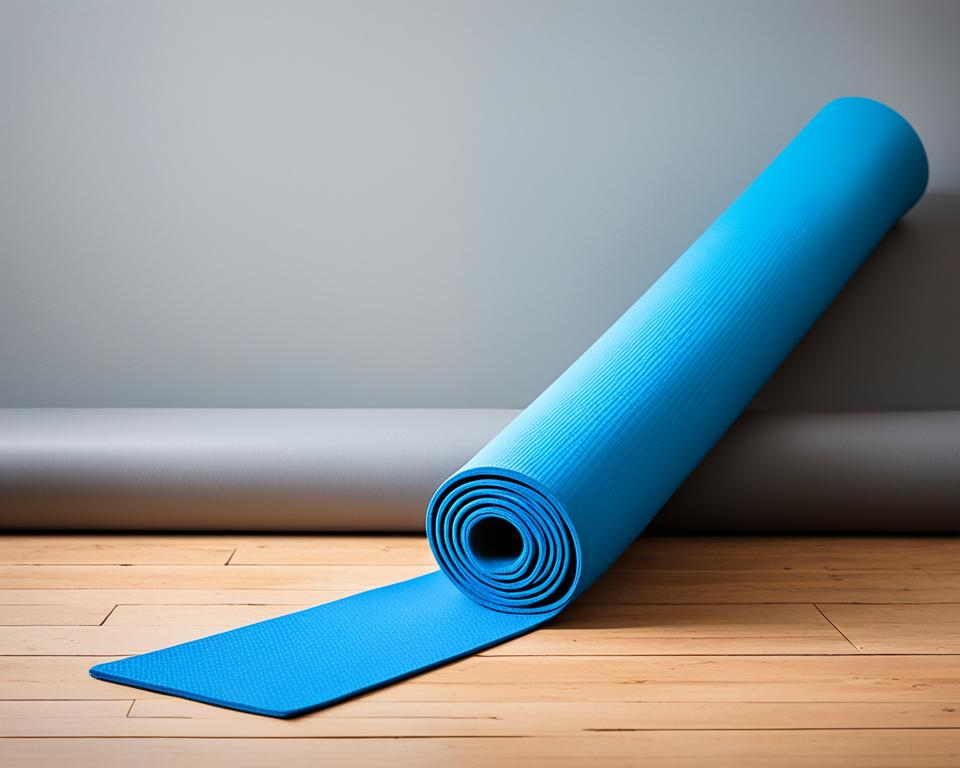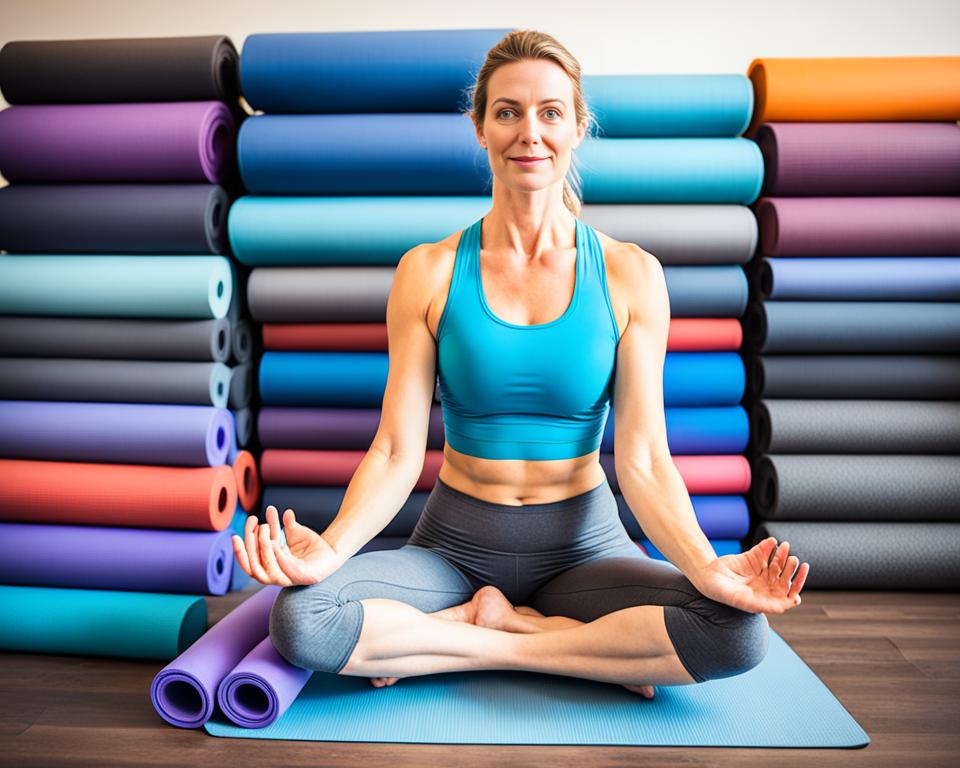The thickness of your yoga mat matters a lot for your comfort. Choosing the right thickness ensures you have the support and cushioning you need. This boosts your yoga experience.
It doesn’t matter if you’re new to yoga or a pro. The optimal comfort helps you keep the right posture, balance, and calm during poses. We want to guide you to the perfect yoga mat thickness for your needs. Let’s explore together.
Understanding the Importance of Yoga Mat Thickness
Yoga mat thickness is key to better practice. A mat is more than a piece of foam. It’s your stable ground, keeping you comfortable and supported in every pose. When it comes to finding the right yoga mat thickness, it’s important to consider your comfort level and the type of practice you engage in. Thick versus thin yoga mats each have their own benefits and considerations.
A thicker yoga mat, typically around 6mm or more, provides extra cushioning for your joints. This is especially beneficial if you have sensitive knees or if you prefer a more restorative or gentle yoga practice. The added padding can make it more comfortable to hold poses for longer periods of time, reducing strain on your body.
The Role of a Yoga Mat in Your Practice
Your mat acts as a shield from the hard floor. It gives you a grip, stopping you from slipping. The sticky part helps you stay aligned and stable for a safer practice.
Cushioning on the mat eases pressure on your joints. This makes practicing more comfortable and lessens the chance of getting hurt. Now, you can focus on breathing and being in the moment.
How Thickness Influences Yoga Poses and Stability?
The right thickness affects how well you do yoga poses. A too-thin mat hurts your joints. Too thick, and balancing in poses becomes a challenge.
A mat with ideal thickness balances comfort with stability. It gives enough cushion for support but doesn’t wobble. This is crucial for a strong foundation in your practice.
Choosing a mat with the perfect thickness can transform your practice. It lets you concentrate on your breath, go deeper in stretches, and keep the right form. This leads to a more rewarding and powerful yoga session.
Comparing Yoga Mat Thicknesses: From Travel to Thick Options
In this section, we’re going to look at different yoga mat thicknesses. Whether you travel a lot, practice often, or need extra cushioning, there’s a perfect thickness for you. Let’s dive into the choices available:
Travel Mats: Light and Ultra-Thin
Travel mats are your best bet for those who are always on the move. They are very light and thin, so they easily fit in bags and suitcases. About 1/16 to 1/8 inch thick, they’re easy to fold or roll.
Even though they’re thin, they still provide a good grip and enough cushion during practice. If you value being able to carry your yoga mat anywhere, these are your top picks.
Standard Mats: The Go-To Choice for Regular Practice
Looking for something for regular use? Standard mats are ideal. They balance comfort with easy transportation well. Their thickness ranges from 1/4 to 1/6 inch.
Standard mats offer enough cushion for various poses. They help keep you stable while practicing. This makes them a great choice for both beginners and experts, whether at home or in a studio.
Thick Mats: Maximum Cushioning for Sensitive Joints
If you need more support for your joints, thick mats are the solution. They’re about 1/2 inch thick or even more. This extra padding is great for your knees and wrists.
These mats are perfect if you have injuries or arthritis. They reduce joint stress and make practice more comfortable. Keep in mind, however, that they’re not as easy to carry around as thinner mats.
The Impact of Yoga Mat Materials on Thickness and Comfort
We will look at how each yoga mat material changes thickness and comfort. It’s key to pick the right one for a better yoga time. Different materials change how you feel during practice, so choosing carefully matters.
PVC: Durable and Grippy
PVC is a favorite for its durability and strong grip. It’s perfect if you don’t want to slide around. With a balance between softness and firmness, PVC mats support your poses well. They last a long time, too.
TPE: Eco-Friendlier Options
TPE is the greener choice, as it’s friendly to our planet and your health. It feels nice to touch, doesn’t slide easily, and is light to carry. You have various thickness options to pick from based on what you like.
Natural Materials: Organic Cotton, Jute, and Rubber
For those leaning towards natural, you can get mats made of organic cotton, jute, or rubber. Organic cotton is very soft, but it’s less thick. The jute is great for grip and lasts a long time. Rubber mats naturally cushion your steps and help you stay put.
How Thick Should a Yoga Mat Be for Specific Yoga Styles?
When picking a yoga mat, think about your yoga style. The right thickness gives comfort and stability. This depends on the yoga you do.
For gentle styles like Yin or Restorative yoga, go for a thick mat. It adds comfort and support for slow poses. You can really relax into each one.

But, if you do active types like Ashtanga or Power yoga, choose a thinner mat. It helps with stability and grip. This is key for staying balanced in tough moves.
For styles in the middle, like Vinyasa or Hatha yoga, a medium thickness works best. It balances comfort with the need for stability. You can move well in sequences and have enough support for poses on the ground.
Your best mat thickness is what you like and what your yoga needs. Try different thicknesses to see what fits you better.
More thickness isn’t always better for all yoga. It could make you less stable in active types. And less thickness might not give gentle practices enough support. Pick the thickness that improves your yoga, no more or less.
Additional Considerations: Body Type and Personal Comfort
When picking a yoga mat, consider your body type and what feels comfy to you. These are as important as the type of yoga you do and the mat’s material.
Finding the Right Balance for Your Body
If you’re bigger or curvier, a thicker mat gives you more support. It cushions you better, making yoga more comfortable.
But if you’re smaller, a thinner mat might feel better. It helps you stay stable and feel closer to the ground, which is good for some poses.
Think about what keeps you steady and supported based on your body’s needs.
Adjusting Mat Thickness for Injury Prevention and Support
Finding a mat that feels good matters a lot, too. It should help you stay aligned and stable without being hard on your body.
For people with joint issues, a thick mat offers extra cushion. This can lessen the impact of yoga on your joints.
Yet, if you prefer firmness for better balance in poses, a thinner mat may be ideal. It supports your balance and control better in certain exercises.
The right mat thickness avoids injury and enhances your yoga experience.
Fitting Yoga Mat Thickness into Your Lifestyle: Portability and Storage
Choosing the right yoga mat thickness is key for your lifestyle. If you travel a lot or mainly do yoga at home or a studio, you need to think about portability and storage.
Traveling with Your Yoga Mat: Compact and Foldable Options
Like practicing yoga on the move? Portable and foldable yoga mats are perfect for you. They’re light and small, fitting easily in a bag or even a suitcase. Their design lets them be placed in tight spots, perfect for keeping up with yoga no matter where you are.

Storing Your Yoga Mat at Home or in the Studio
Storing your yoga mat can be simple at home or in a studio. For tight spaces, get a mat that rolls up and is easy to hide. Mats that are flexible work best for this, fitting in small spots.
If you have a spot just for yoga, showing off your mat might be more your style. A mat rack or wall mount can make your mat look good and be easy to grab. This trick clears up space and looks nice when you practice yoga.
Thinking about portability and storage is smart. It helps you use your yoga mat every day, whether out and about or relaxing at home.
How to Choose the Right Thickness for Your Yoga Mat: Practical Tips
Choosing the right thickness for your yoga mat is crucial. Try out different mats to see what feels best for you. This allows you to pick the perfect mix of comfort and support.
Get a variety of yoga mats with different thicknesses. You need this assortment to grasp how each thickness works. Try mats that are 3mm, 5mm, and 7mm to see their effects.
Set some time to test each mat. Start with the first mat and try various poses. See which thickness feels the most comfy and secure. Note any poses that become easier or harder with each thickness.
Ask yourself some key questions while testing mats:
- Is the mat thick enough for joint support?
- Does the thickness affect your balance in poses?
- How does the mat thickness feel in different poses?
Answering these questions and trying different mats helps you know what’s best. Remember, the ideal thickness varies for each person. Find what suits your body and practice best.
After testing mats, pick the one that meets your needs. With the right mat, your yoga journey will be more enjoyable and beneficial. So go ahead, test out those mats, and find your perfect fit!
It’s key to pick the best yoga mat thickness for your needs. We discussed many things influencing this choice. This guidance aims to make your decision easier.
The right mat thickness is very important for your yoga. It makes poses more stable and protects your joints. Choose based on your type of yoga and what feels good to you.
Think about your body size and what you find comfortable. Also, think about whether you need to carry the mat a lot. There are thin and light mats for those who are always on the go or have little space at home.
To end, choosing the ideal mat thickness means thinking about comfort, support, and if you can take it everywhere. Consider your personal needs and the type of yoga you do. This way, your yoga sessions will be better with the right mat thickness.l
FAQs
How thick should a yoga mat be for optimal comfort?
A yoga mat’s perfect thickness varies based on what feels comfortable to you and the yoga type. Typically, 4 to 6 millimeters thick mats offer the best cushioning without sacrificing stability.
What is the role of a yoga mat in your practice?
A yoga mat acts as a soft, stable layer during exercises. It improves your balance, comfort, and safety by absorbing the shock of movements. This way, it helps you do your poses more effectively.
How does the thickness of a yoga mat influence yoga poses and stability?
Mat thickness directly affects how well you balance in poses. Thicker mats ease pressure on joints, making them ideal for poses that need more cushioning. In contrast, thin mats help with balance poses by keeping you connected to the ground.
What are the different thickness options for yoga mats?
Yoga mats come in a range of thicknesses. Travel mats are light and thin, perfect for on-the-go. Regular mats, at 4 to 6 millimeters, are great for daily use. Thicker mats, at 8 to 10 millimeters, offer the most cushioning for comfort.
How do yoga mat materials impact the thickness and comfort of the mat?
The material of a yoga mat decides its thickness and comfort. PVC mats last long and have a good grip, making them suitable for all. TPE mats are environment-friendly. Natural mats, like organic cotton and rubber, have different thicknesses and comfort levels.
How thick should a yoga mat be for specific yoga styles?
For gentle types such as Hatha or Yin, choose a thicker mat for extra comfort. Focusing on dynamic practices like Ashtanga or Vinyasa? A thinner mat brings better stability and balance.
What additional considerations should be made when choosing the thickness of a yoga mat?
When picking a mat’s thickness, think about your body and what feels good to you. Finding the right mix of comfort and firmness is key. This choice can help avoid injuries and enhance your practice.
How can I fit yoga mat thickness into my lifestyle?
If you travel a lot, go for mats designed for it. These mats are thin and light, fitting easily into luggage. At home or in a studio, ensure storage space keeps your mat clean and ready to use.
How do I choose the right thickness for my yoga mat?
Finding the best mat thickness requires testing different ones. Look for a mat that’s stable and supports your yoga moves. Trying mats out yourself is a great way to decide what suits you.

